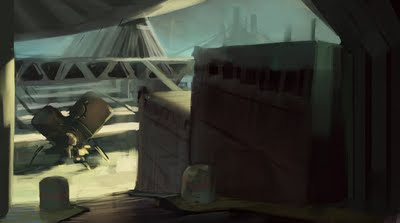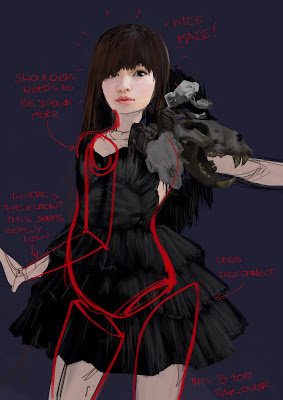I was thinking it might be a good idea for us to each kind of establish what it is we feel we really want to work on or what our biggest weaknesses are. And also to highlight the ones that are the obvious weaknesses and the ones we might typically try to ignore. This could be especially effective for getting quick improvement on these issues. If we all know everyone else's weaknesses and what they're focusing on, critiques can be tailor made so we don't linger on what's unimportant and just focus on tuning up the weakest link.
For me, the one I try to ignore is my difficulty with hard lined objects. Buildings, machines, etc. So that's one thing that I usually just try to carefully avoid and now I want to try to tackle head on, no matter how embarrassing.
So with that said I started looking at the work of artists that I really admire in terms of environments and everything else and try to piece together information about why what they do looks so good. Here are my thoughts. Please comment and your own.
I snagged all these images but one from the CA.org EOW category winners and will credit them accordingly. The first is a sketch by
Andrew Ley. What I was noticing as I looked at all of these works amidst the rest of the EOW competitors was that the ones that fell flat didn't really do so because of design, though that was part of it, they were mostly just flat and had no sense of space whatsoever. When I started trying to figure out why and how these works particularly are successful I started to see some running trends.

The first of these is that in the most effective concept pieces, the artist took every chance they had to use perspective. Every chance. It's to the point where I would wonder if the design is almost determined by the needs of the image at times, meaning the shapes of buildings and their surroundings change in accordance with the composition, not just the ideals of the artist. In Andrew's piece he's turned the ground plane into a grid so we can easily see receding space as well as using atmospheric perspective. He also reinforces the perspective by having repeating columns on the sides that are basically perspective markers. The scratchy lines on the pavement also make sure that the ground really appears flat.
The next guy,
Stokes does some of the same tricks. He pushes the atmospheric perspective to really make things go back in space. He uses another dominant vanishing point in his composition but he introduces something interesting. He doesn't just have pipes receding into space, he makes catwalks and planks that zigzag across them which give us some real scale and distance, especially with the figure. It's also good to note that neither of these guys made the horizon line parallel to the picture plane, always on a tilt.
 Craig Mullins
Craig Mullins is of course the man, and one thing that I noticed about his works is that whenever he has flat surfaces, any at all in his environments, he puts a texture or pattern on them to let us see how it recedes. Rarely do you ever see him use flat color. The result is this awesome grid floor which, in addition to the figures standing on it, let us see tons of space. He's a master of atmosphere too, and that helps.

This piece by
Hideyoshi does a lot of things well but falls short in other ways. It's increbly detailed and complex, but it really just goes to show how you cannot use some of the rules of perspective and ignore others if you want to create something that is really successful. His super tight line drawing is beautiful in the foreground but as you get to distant buildings with the same amount of detail, it destroys the space and the illusion is lost, the lack of atmosphere and loss of detail that you find Mullins' work I think is really holding back this piece, no matter how good it is technically. That said, this guy is consistently awesome and this is a much older piece of his, talk about a draftsman.

That was probably a huge torrent of blather that none of you wanted to hear but verbalizing for myself helped me really solidify things that I'd learned from really looking into these artists' work. I ended up just seeing how I could try to build images with lines and composition to see if I could get THAT right first before I try going into an expanded value range and the use of color. Nothing to sneeze at but I don't think that's really what we're about here anyways. It's learning right? Thoughts please on all of the above and below?


eth.













